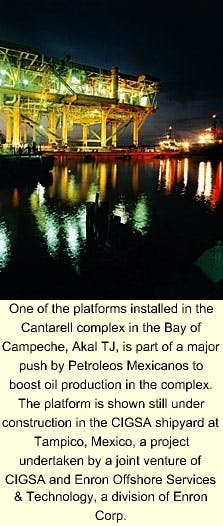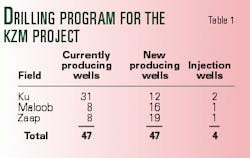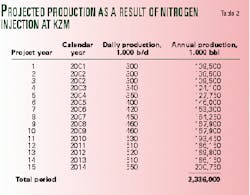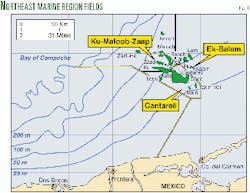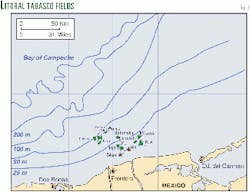Mexico's New Energy Era: Mexico's new government launches major projects to boost oil production
Fabio Barbosa
Universidad Nacional Autónoma de México
Mexico City
The Petroleos Mexicanos 2001-06 upstream investment program that was recently approved by the new administration of Mexican President Vicente Fox covers a variety of projects, many of them intended to elevate oil and natural gas production.1
This article presents an overview of the most important projects under this program for increasing output of heavy and light crude oil. At the top of the list are these projects:
- A massive new nitrogen injection project intended to boost oil and gas recovery in fields in the Bay of Campeche.
- An extensive field development project in the coastal Tabasco province.
- A comprehensive program to boost production in the Delta del Grijalva region.
Nitrogen injection
The Ku-Zaap-Maloob (KZM) complex is, according to the Pemex 1996-99 review of reserves, Mexico's second largest group of fields, surpassed only by the supergiant Cantarell complex. It has proven and possible reserves of oil and gas approaching 5 billion boe.
The geology of the complex was unveiled in a process of nearly 10 years of exploration in the Northeast Marine Region. The first field to be discovered was Ku, in 1979. Maloob was discovered in 1985, and Zaap in 1988.
Ku was put on production in March 1981 and by October 1983 was producing 200,000 b/d of oil. The other two fields were drilled sparsely, consequently contributing very little production (Table 1).
Artificial lift systems were initiated in 1991 in the Ku-427 and Ku-445 wells. Later, in 1996, new pneumatic pumping systems were introduced in Ku, and the infrastructure equipment was optimized, thus elevating production to nearly 300,000 b/d.
What studies revealed
Combined geology, geophysics, and engineering studies revealed an advanced state of depletion at Ku.
Nitrogen injection to the secondary gas cap was recommended to maintain pressure.2
Nitrogen injection is also under way to sustain reservoir pressure and boost oil recovery in the Cantarell complex (OGJ, Mar. 12, 2001, p. 41).
Studies also indicated that the reservoirs are hydraulically connected and, therefore, the production of any one of them affects the bottom pressure of all others. Although only Ku has been actually developed, pressure has diminished in the complex as a whole as production advanced in Ku. This pressure drop can be observed in Zaap, even though its own production has been marginal.
It was decided that in order to recover remaining reserves in the complex, the number of development wells should be increased to triple the existing 47 wells. The initial proposal was to drill 84 new production wells, plus some injection wells. Due to budgetary constraints, the new administration approved only 47 new wells. This restriction in production ability is a characteristic of the Mexican upstream (Table 1).
Also approved was a budget to install 11 new offshore platforms and two new pipeline compression and pumping complexes. For transportation, 11 oil and gas pipelines, 3 oil pipelines, and 30 gas pipelines were initially proposed. Of this 44-pipeline system, only 22 obtained funding.
Table 2 shows projections of expected production after the project begins. Nitrogen injection would allow an incremental production of little over 1 billion bbl of crude oil. Peak production would be reached after 15 years into the project.
Regarding natural gas, nitrogen injection-assisted production could reach an estimated 450 bcf.
Litoral Tabasco project
In the early 1990s, oil policy took a turn in Mexico, as evinced by the characteristics and the number of drilling service contracts.
The reactivation of exploration and production in the Bay of Campeche culminated with the discovery of 16 new fields in what Pemex calls the Southwest Marine Region. Some of these fields contain multiple productive formations and, to date, a total of 26 new reservoirs have been identified. Based on these results, the Litoral Tabasco group of fields was defined.
These fields awakened keen interest for two reasons. First is the high quality of the light and ultralight crude oils. These fields yield crude oil of 35-51° API gravity. The only exception is Sinán, a Cretaceous reservoir that yields 30° gravity crude oil. The second reason for the area's appeal is the high gas-oil ratio-nearly 2,350 cf of gas per barrel of crude oil produced-which is nearly double the value of other Mexican offshore fields and a notable exception to the national average.
After their discovery, these 16 fields remained undevloped for nearly a decade. The exception is Kax field, which since it was put on steam in September 1995, had produced almost 11 million bbl of crude oil and nearly 23 bcf of natural gas by December 2000.
The program envisioned by Pemex's new administration will not incorporate all of the Litoral Tabasco fields in 2001. Only six light crude oil reservoirs have been targeted-Citam, Sinán, Bolontikú, Kab, Yum, and May-Pemex Director General Raúl Muñoz Leos has announced. Production is expected to peak at 110,000 b/d of light and superlight crude oil and 288 MMcfd of natural gas. To reach these targets, it will be necessary to drill 24 new wells and to install 12 new offshore platforms during 2001-06.
Delta del Grijalva project
Delta del Grijalva is a top priority program that was initiated in a very limited manner and which, in fact, had been postponed in the face of sharp budgetary constraints.
The new administration made this project its first order of business to obtain financing for this project. A few weeks after Fox took office last January, Muñoz Leos said, in a presentation at a Center for Strategic & International Studies conference in New York, "The litmus test will be whether we are allowed to obtain external financing to be able to develop the light crude oil reserves in Tabasco with foreign financing." He went on to explain, "Although 40% of the proven oil reserves in Mexico are of light crude, only 20% [of Mexican oil production] is of this type of oil. Pemex's foremost priority to increase the production of light crude oil will be to invest more aggressively in the development of old fields that are now declining more rapidly than was expected."
According to Muñoz Leos' estimates, "Mexico could earn an additional $1.5 billion if these resources are developed."
The Mexican government authorized the project to proceed in February 2001, and Pemex was able to issue bonds for $1.5 billion on international markets through the Pemex Project Funding Master Trust, with which the necessary financial resources were ultimately obtained.3
Delta del Grijalva background
The Delta del Grijalva program, now in progress, was also the result of more recent studies and a reevaluation of Mexican reserves. It consists of a small group of 10 fields of which 3 are, due to their proven reserves and productivity, most important: Caparroso, Sen, and Luna.
Geologically, they belong to the structure known as Pilar Reforma Akal, which has its origin in the Norte de Chiapas and crosses part of the Tabasco territory toward Cantarell. All the fields in this project are Mesozoic, except Tizón, which produces from Tertiary sands. This structure, like the others, was uncovered gradually over several exploratory campaigns, which revealed its extension and characteristics. The productive Cretaceous pay zone of southeastern Mexico was first penetrated in 1972, in the Cactus and Sitio Grande fields in Chiapas state. The following 10 years provided ample proof of is continuity. In the 1980s, the first Cretaceous reservoirs on the Tabasco coast were discovered, in the Grijalva River delta. Caparroso, a 150 million bbl field, was discovered in 1982. Two years later, a small giant, Sen, boasting 300 million bbl of oil, was found followed by Luna, with 100 million bbl.
The other discoveries are basically extensions of known fields, small fields, or new reservoirs in lower strata, such as the 1992 discovery of Escarbado field.
High-quality crude
The 10 fields in the Delta del Grijalva complex have two common characteristics. First is the quality of its crude oils, which exceeds 40° gravity-and in Luna is as high as 45° gravity. Second, there is the presence of very active aquifers that have a dominant influence in the behavior of the reservoirs. This can be advantageous or, as it happens, can become a problem that causes the wells to flood prematurely.
In identifying the physical characteristics of reservoirs, i.e., extension, geometry, thickness of the strata, etc., it is crucial to understand the type of energy that makes the hydrocarbons flow. It may be associated gas, or free gas in the overlying gas cap. In the Delta del Grijalva fields, it is hydrostatic pressure that makes contact with the oil in a lower plane. This is an additional advantage, because this natural energy allows a recovery of over 50% of reserves. This and the prevailing high-pressure conditions make expensive artificial production systems unnecessary.
The production history of these aquifer-influenced Tabasco fields has been uneven and checkered with sudden declines, which is the reason why this program is deemed urgent.4
Water incursion
Although the push of the aquifer can be an advantage, without the proper management of the water masses below the formations, which can require considerable investment, wells drilled in the lower strata of the structure and near the flanks can be prematurely flooded.
Since the review and subsequent analysis of Caparroso-Pijije-Escuintle field, which currently features the greatest reserves in the Delta del Grijalva complex, it has been proven that water incursion was the reason why, of the 25 wells drilled, nearly half had to be shut down. The analysis coverd nine blocks, six of which are producing. Pressure tests indicated that they are connected, and thus water masses move along high-permeable fractured zones associated with normal faults.
Sen has the same problem. Of 22 wells drilled in this field, the most prolific in the complex developed during the 1980s, only 13 remain active. Its production of light, 44° gravity oil fell from 51,000 b/d in 1997 to 42,000 b/d in 1998 and to 38,000 b/d in 1999.5 This rate of decline can be reversed. Gas production also collapsed, from 140 MMcfd in 1997 to 122 MMcfd in 1998, and to only 106 MMcfd by 1999.
The last quarterly report of the annual operations program of the Southern Region indicates that the decline in production was due to the "choking of the wells due to the high water content."6
In the other large delta reservoir, Luna, of 33 wells drilled, only 8 are producing now. The record also shows abrupt production declines, from 36,000 b/d to 11,000 b/d during 1993-97. Recently, production has rebounded to 20,000 b/d.
According to the assistant director for the Southern Region, of the 90 wells drilled in the Delta del Grijalva complex, only 36 are now in operation, which means that 60% of the wells had to be shut down.
Aquifer management and remediation of potential damage require some basic measures:
- Well relocation by drilling new development wells in higher parts of the structure, which will be the last to be drilled.
- Major repairs to the group of wells.
Furthermore, the program requires only one separation battery to handle the newly produced gas.
It should be stressed that, since the last report of the past director of Pemex for the previous 6-year period (Mar. 18, 2000), it was announced that the program had already started, although due to the stringent budget, the action was limited to two wells drilled, Luna-D and Escuintle-13. As threatened wells become rehabilitated under the new administration, a new peak in production is to be expected.
Light crude oil production from Delta del Grijalva fields could jump from the current 70,000 b/d to 102 000 b/d by the third year of the program. Gas production will increase from 260 MMcfd in 2000 to 360 MMcfd, also by the third year of the project.
Considering all the steps that will be taken, this program will make possible the recovery of almost 600 million boe in the next 15 years-about 300 million boe due to natural production and a little over 250 million boe in incremental production due to the Delta del Grijalva program.
References
- Pemex Exploración y Producción, "Programa de Inversiones 2001," Monterrey, Nuevo León, Feb. 17, 2001.
- For a summary of the program, we used Las Reservas de Hidrocarburos de México, Vol. 1, Mexico, Pemex, 2000; and "Proyecto de Modernización y Optimización del Campo Ku," Rafael Vega Monter, Mexico City, 1998, a paper presented at the Technology & Petroleum Equipment Exposition, Mexico, 1998.
- Pemex, Gerencia Corporativa de Comunicación Social, Mexico City, Bulletin No. 23/2001, Feb. 12, 2001.
- Results of the studies and the Delta del Grijalva project were published by Carlos Morales Gil, assistant director for the Southern Region, Pemex Exploración y Producción, Southern Region, Bulletin, Villahermosa, Tabasco, 1998.
- Pemex, Anuario Estadístico 2000, at http//www.pemex.com.
- Pemex Exploración y Producción, Southern Region, Annual Operations Program, Third Quarter Report, 2000, Villahermosa, Tabasco.
The author
Fabio Barbosa Cano is a professor of history, teaching in various schools at the Universidad Nacional Autónoma de México. He has focused on issues concerning challenges with petroleum exploration and production technology in Mexico. Barbosa has published a number of articles on technical and economic problems of the Mexican petroleum industry and Mexico's petroleum resources and is a regular contributor to the Mexican trade publication Petróleo y Electricidad. Fabio Barbosa is the author of Exploración y Reservas de Hidrocarburos en México, a book published by UNAM-Miguel Angel Porúa Editores, 2000.

